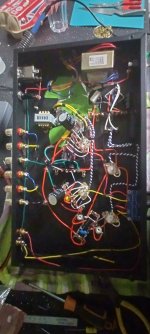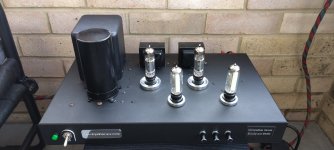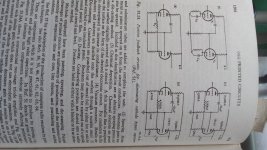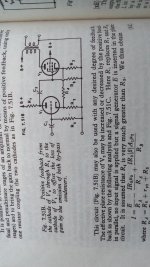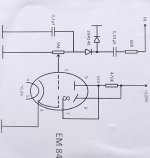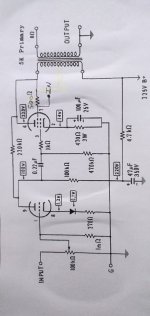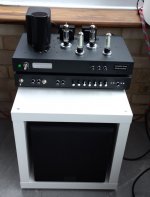I have been busy building a PCL82 based amp with EM84 dancing indicator valves.
Based on stephe's 6BM8 amp design.
Reusing parts so didn't have the option to ultralinear the output. Nevertheless the result is rather nice sounding, especially combined with a little subwoofer I have rebuilt using a cheap Chinese plate amplifier.
A little cheapie passive tone board provides volume, bass and treble control and seems to operate really well for very little effort 0 money.
Currently using shade feedback resistor of 220k not sure if I should up this given the lack of ultralinear.
Cheers
Based on stephe's 6BM8 amp design.
Reusing parts so didn't have the option to ultralinear the output. Nevertheless the result is rather nice sounding, especially combined with a little subwoofer I have rebuilt using a cheap Chinese plate amplifier.
A little cheapie passive tone board provides volume, bass and treble control and seems to operate really well for very little effort 0 money.
Currently using shade feedback resistor of 220k not sure if I should up this given the lack of ultralinear.
Cheers
Attachments
Wonderful. Purist of audio will say pentodes are thrash, but they are precious pieces.
I remember a very old wincofon (a simple record player made in Argentina under licence) from my grandpha's that in many events we played songs of Pink Panther and the like during several hours. It was powered by a ECL82 and 6X4, so it isn't no more than it to enjoy lot of time playing lots of songs.
I remember a very old wincofon (a simple record player made in Argentina under licence) from my grandpha's that in many events we played songs of Pink Panther and the like during several hours. It was powered by a ECL82 and 6X4, so it isn't no more than it to enjoy lot of time playing lots of songs.
Yes it's surprising just how good these tubes sound especially when you consider they were originally designed for use in televisions to power little tiny tinny speakers.
It isn't true you can't make it run UL. You can simulate it using a resistor voltage divider across the OPT and wire the screen to the midlle of them. Surely it isn't as well performer as a true UL, but it will do its job, with a benefical reduce in screen voltage will make those pentodes run less hot.
3W from them isn't negligible at all. Such tubes also make good series pass regulators, using triode as voltage amplifier and pentode as series element. I did 3 or 4 of them.
3W from them isn't negligible at all. Such tubes also make good series pass regulators, using triode as voltage amplifier and pentode as series element. I did 3 or 4 of them.
Now, that's an interesting idea. I will look into simulating ultralinear next. I'll let you know the outcome.
Thanks Ian
Thanks Ian
👍
You can also, return the cathode to the secondary of the OPT. This was a common practice in TV and radios that don't need any extra stuff, and you may wish it act to negative feedback the output stage in order to improbe a little its behaviour.
You can also, return the cathode to the secondary of the OPT. This was a common practice in TV and radios that don't need any extra stuff, and you may wish it act to negative feedback the output stage in order to improbe a little its behaviour.
There is another thing to play around that "audiophiles" usually ignore. It is the use of small amount of positive feedback to the stage. You need to remove capacitors at the cathodes of both triode and pentode, provided the volume control isn't wired between them. Thus, add a large potentiometer wired as variable resistor, unusing one extreme, and join it between both cathodes. This is an old trick few people experimented but give excellent results. As there isn't capacitor no more with its low frequency roll off, thus, better bass are found. You can further play with any RLC network between cathodes to obtain the frequency profile you want.
Starting this pot at the higher ohmic value (10K is a good starting point), slowly decrease until amp starts to oscillate, then, go back a little.
This idea is, certainly, not mine but I played with it and interesting things one can learn.
(Pic from "Langford Smith" Radiotron pages 354 and 1284).
Starting this pot at the higher ohmic value (10K is a good starting point), slowly decrease until amp starts to oscillate, then, go back a little.
This idea is, certainly, not mine but I played with it and interesting things one can learn.
(Pic from "Langford Smith" Radiotron pages 354 and 1284).
Attachments
Attached are the circuit diagrams for my implementation
Based on stephe 's design but without UL and with EM84 magic eye tubes. I have annotated where the EM84 circuit connects into the amp for anyone unsure.
Hopefully stephe will not mind me posting this here, but I will remove it if she wants me to obviously.
Cheers Ian
Based on stephe 's design but without UL and with EM84 magic eye tubes. I have annotated where the EM84 circuit connects into the amp for anyone unsure.
Hopefully stephe will not mind me posting this here, but I will remove it if she wants me to obviously.
Cheers Ian
Attachments
You adjust the rate of closure of the magic eyes via potentiometers inside the chassis as shown on the circuit diagram
Thanks! Even a single mono eye tube would be cool I suppose you could put an on/off switch on them too.
That doesn't work well, I tried it many years ago.It isn't true you can't make it run UL. You can simulate it using a resistor voltage divider across the OPT and wire the screen to the midlle of them.
Here is my solution from 1960, scanned my a very old note book.
Complete with some actual measurements.
Attachments
- Home
- Amplifiers
- Tubes / Valves
- PCL82 Amp Build
